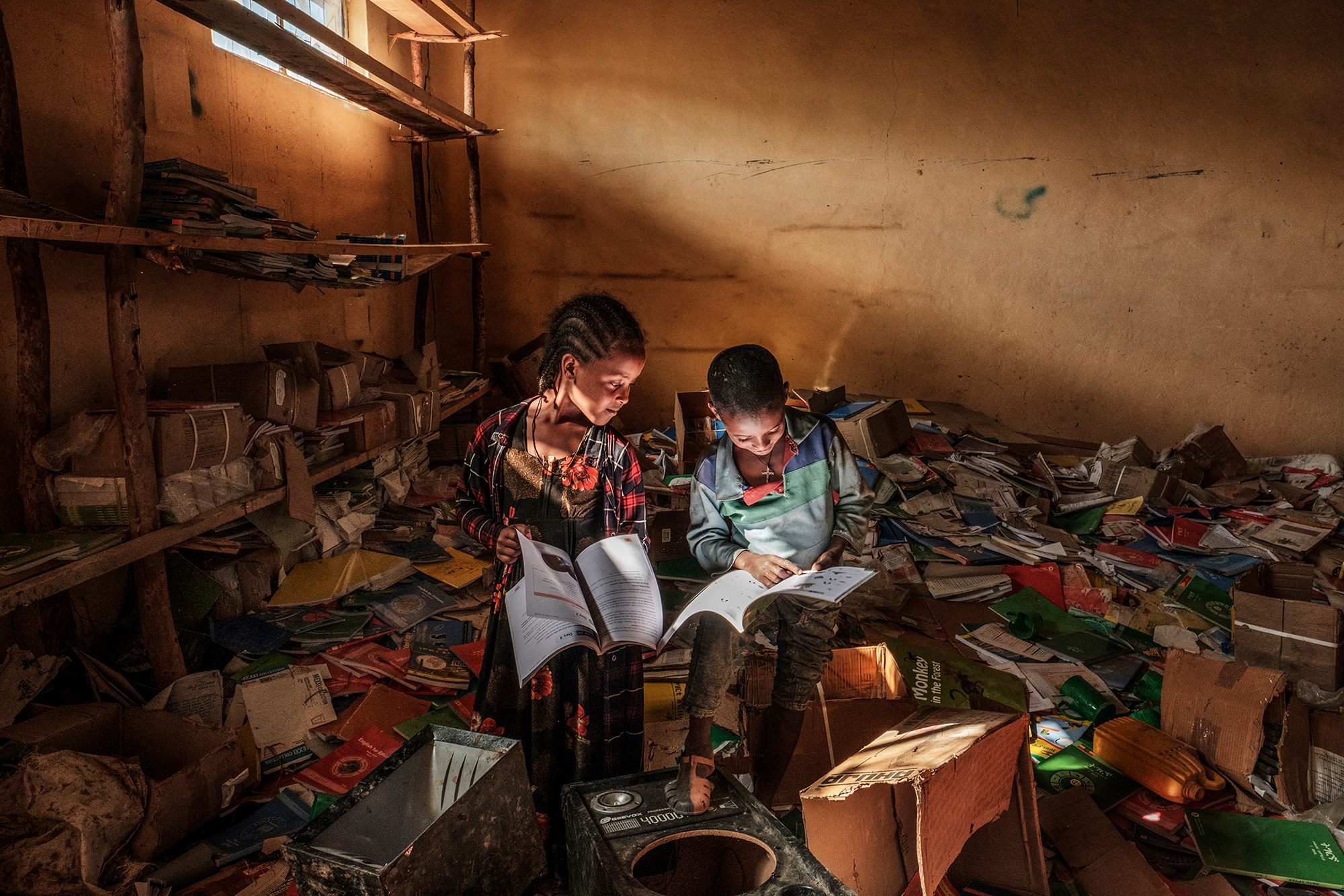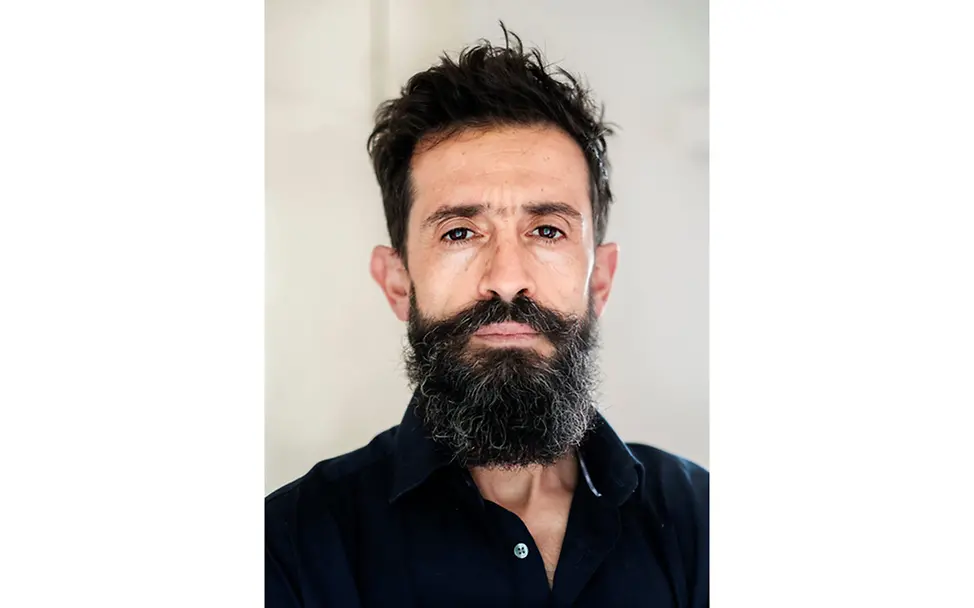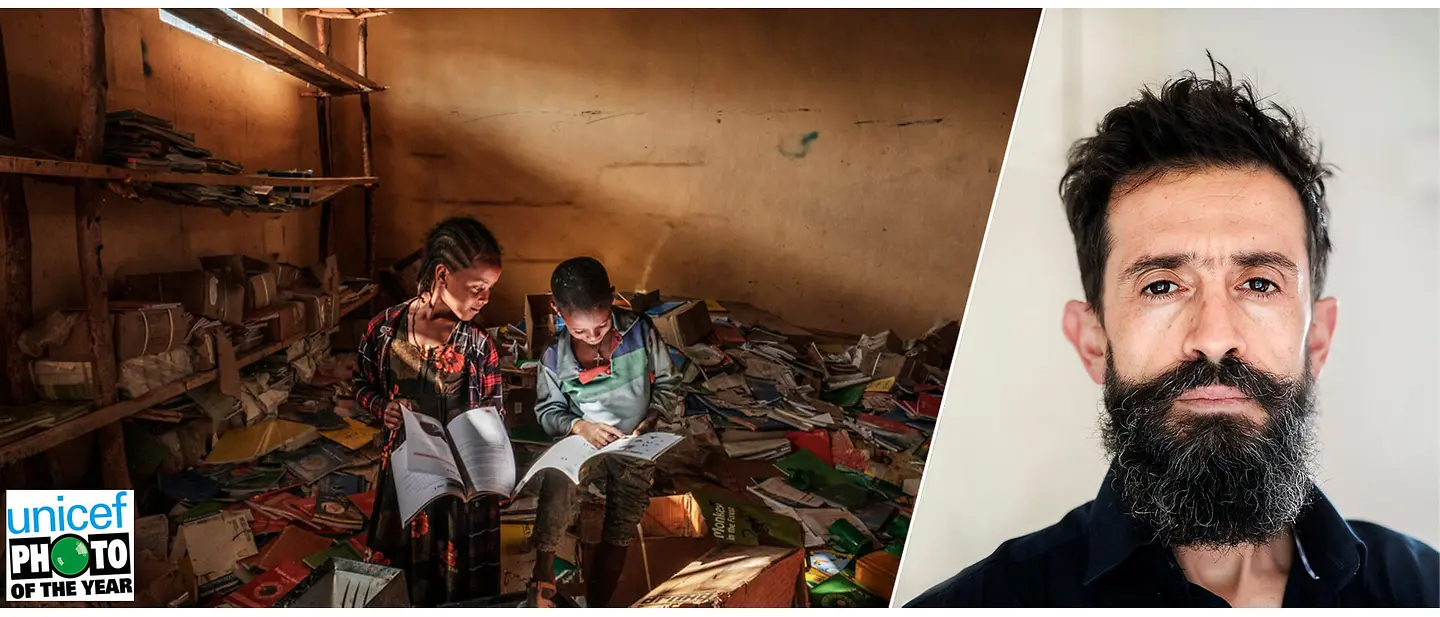UNICEF Photo of the Year 2022
Each year, UNICEF Germany has awarded the “UNICEF Photo of the Year Award” to photos and photo series that best depict the personality and living conditions of children worldwide in an outstanding manner. Here are the winners 2022. Text: Peter-Matthias Gaede, UNICEF.
Eduardo Soteras, Argentina
Tigray, Ethiopia: Taking Refuge in Books

Although destroyed, the library in this elementary school in Ethiopia’s Tigray region is where two children have taken refuge in books. This little moment of happiness shows in their smiles. It is a rare moment. Because of the armed conflict with the central government, 5.2 million people in this region in northern Ethiopia are suffering from violence, displacement, malnutrition and a shortage of drinking water.
Argentinian photographer Eduardo Soteras has been documenting the situation of children in Tigray since 2020: in refugee camps, in hospitals, in reception centres for girls who have been sexually abused. For example, when they are collecting firewood and looking for water. And he captures rare moments like the one that shows what the children of Tigray share with children all over the world: the need to be allowed to engage peacefully and curiously in something that brings them joy.
 Bild 1 von 17 © Eduardo Soteras, Argentina, AFP (Agence France Press)
Bild 1 von 17 © Eduardo Soteras, Argentina, AFP (Agence France Press) Bild 2 von 17 © Eduardo Soteras, Argentina, AFP (Agence France Press)
Bild 2 von 17 © Eduardo Soteras, Argentina, AFP (Agence France Press) Bild 3 von 17 © Eduardo Soteras, Argentina, AFP (Agence France Press)
Bild 3 von 17 © Eduardo Soteras, Argentina, AFP (Agence France Press) Bild 4 von 17 © Eduardo Soteras, Argentina, AFP (Agence France Press)
Bild 4 von 17 © Eduardo Soteras, Argentina, AFP (Agence France Press) Bild 5 von 17 © Eduardo Soteras, Argentina, AFP (Agence France Press)
Bild 5 von 17 © Eduardo Soteras, Argentina, AFP (Agence France Press) Bild 6 von 17 © Eduardo Soteras, Argentina, AFP (Agence France Press)
Bild 6 von 17 © Eduardo Soteras, Argentina, AFP (Agence France Press) Bild 7 von 17 © Eduardo Soteras, Argentina, AFP (Agence France Press)
Bild 7 von 17 © Eduardo Soteras, Argentina, AFP (Agence France Press) Bild 8 von 17 © Eduardo Soteras, Argentina, AFP (Agence France Press)
Bild 8 von 17 © Eduardo Soteras, Argentina, AFP (Agence France Press) Bild 9 von 17 © Eduardo Soteras, Argentina, AFP (Agence France Press)
Bild 9 von 17 © Eduardo Soteras, Argentina, AFP (Agence France Press) Bild 10 von 17 © Eduardo Soteras, Argentina, AFP (Agence France Press)
Bild 10 von 17 © Eduardo Soteras, Argentina, AFP (Agence France Press) Bild 11 von 17 © Eduardo Soteras, Argentina, AFP (Agence France Press)
Bild 11 von 17 © Eduardo Soteras, Argentina, AFP (Agence France Press) Bild 12 von 17 © Eduardo Soteras, Argentina, AFP (Agence France Press)
Bild 12 von 17 © Eduardo Soteras, Argentina, AFP (Agence France Press) Bild 13 von 17 © Eduardo Soteras, Argentina, AFP (Agence France Press)
Bild 13 von 17 © Eduardo Soteras, Argentina, AFP (Agence France Press) Bild 14 von 17 © Eduardo Soteras, Argentina, AFP (Agence France Press)
Bild 14 von 17 © Eduardo Soteras, Argentina, AFP (Agence France Press) Bild 15 von 17 © Eduardo Soteras, Argentina, AFP (Agence France Press)
Bild 15 von 17 © Eduardo Soteras, Argentina, AFP (Agence France Press) Bild 16 von 17 © Eduardo Soteras, Argentina, AFP (Agence France Press)
Bild 16 von 17 © Eduardo Soteras, Argentina, AFP (Agence France Press) Bild 17 von 17 © Eduardo Soteras, Argentina, AFP (Agence France Press)
Bild 17 von 17 © Eduardo Soteras, Argentina, AFP (Agence France Press)
Photographer: Eduardo Soteras, Argentina (Agence France-Presse)

Eduardo Soteras, born in 1975, studied economics before he decided to work as a photographer. His work first took him to Palestine, then to Spain, Mexico, later to the Himalayas, the Democratic Republic of Congo, and as of 2018, to Ethiopia.
His work on refugee movements in Central America, published in 2011, was named best photography book of 2011 in the U.S.; his photos are shown at major photography festivals and regularly published in international media.
Argentinian photographer Eduardo Soteras has been documenting the situation of children in the conflict in northern Ethiopia since 2020. In doing so, he has managed to capture such rare moments as the one we see in this year’s UNICEF Photo of the Year: Although destroyed, this elementary school library in Ethiopia’s Tigray region is where two children have taken refuge in books. It is a rare moment of joy in the midst of destruction and violence. An interview.
An interview with the winner of the UNICEF Photo of the Year 2022
I met this year’s award winner, Argentinian photographer Eduardo Soteras, for a video interview in November. I wanted to know more about his work as a photographer and his photo project in Ethiopia. The conflict in northern Ethiopia has put the civilian population in need of urgent humanitarian assistance. Eduardo has been able to document parts of the conflict.
Dear Eduardo, congratulations on your success. Have you always had a passion for photography?
Eduardo Soteras No. (laughs) I used to be a tax accountant. I did ‘terrible’ things – bank audits, taxes, accounting. Because I got rather quickly fed up with that, I packed my backpack and set off for Europe at the age of 22.
Although I come from Córdoba, the second largest city in Argentina, I had no idea about creative professions. I had never met a photographer before in my life. It was a special experience in Prague that opened the world of photography to me: by pure chance I visited an exhibition of the work of the photographer Josef Koudelka. I was completely overwhelmed, as I hadn’t known before how absolutely amazing photography could be. Okay, it may well be that memories can transform experiences into something poetic. Seriously, though: I had never seen anything so inspiring.
I returned to Cordoba and put on my tie again. After that, I struggled with my professional situation for two years. Because I had seen something that was to change me and my whole life from one moment to the next. To cut a long story short: I saw one of Koudelka’s photos and instantly fell in love with photography. I left Argentina and found a way to turn my passion into a profession.
What led to your photo series ‘Ethiopia’s Children in War’?
Eduardo I moved to Ethiopia as a photographer for Agence France-Presse (AFP), having previously worked in the Democratic Republic of Congo for several years. As a photographer for a news agency, part of my job is to document the situation on the ground. This was also the case in Ethiopia. The interesting thing this time was that we moved as a family to a place that was in the headlines because of positive changes. There had been a change of government and the economy in the country was growing. Everything seemed to be perfect. Suddenly, the riots began and the conflict escalated. I now had to photograph things that I would never have expected two years earlier. It’s nothing new, but it still needs to be said again and again: it is innocent children who pay the highest price for all the violence and destruction. I think you can see that in my pictures as well.
Your photo project took many months. Tell us a bit more about it…
Eduardo When the fighting broke out, all access to the contested areas was drastically restricted. Thanks to the personal network of my AFP colleagues on the ground, I nevertheless managed again and again to get into various areas. Each of these tours revealed new aspects of the conflict and helped us to understand the complicated context of these terrible events.
Prior to our trips to the war zone, we negotiated possible stops and times with the local authorities – including the day of the visit to Bisober, the place where I took the winning picture. We spent the day in and around a tiny village on the border of the Tigray region. When we stopped in front of a school, we saw people inside the building who eventually invited us in. As you can see from the light in my photo, it was already afternoon. The villagers, who had invited us for a tour,
How exactly did you go about taking the winning photo in the destroyed school library?
Eduardo We looked around the school to get an overview of the situation. As always in such situations, I was extremely careful so that the scenery remained untouched and was not changed artificially. It was sheer luck when the two children appeared to show us around. I had already been in the school’s library for a few minutes. The light was already very good and the sight of books scattered everywhere on the floor presented an excellent subject for a photo. What was missing now for the perfect picture were people. So I waited and continued to look around further inside the ransacked building. Suddenly, the two children started showing us around the library, looking at the books and talking about them. I continued to try to stay in the background as much as possible. In the end, I had the opportunity to take the winning photo.
Afterwards, the children led us through the other rooms of the school. Meanwhile, I focused on just letting them get on with it, without giving the impression that I was expecting anything from them. That’s because ethical aspects are extremely important to me in carrying out my work. Any scene, no matter how impressive and unique, is worthless as soon as I manipulate it by asking the people involved to behave according to my wishes.
What else do you know about the two children in the picture?
Eduardo Unfortunately, everything had to happen very quickly. So there was no opportunity to talk to them properly. I concentrated solely on taking photos. Meanwhile, my colleagues interviewed a few of the adults who were also in school at the time.
It is the photographer’s dilemma: as a photographer, I want to know everything about the people in my pictures. But I often have very little time for that and, as I said, I want my words and actions to have as little impact on the people as possible – neither consciously or unconsciously.
What did it look like outside the school?
Eduardo It was a tiny village. I was told that many young people have lost their lives because of the conflict. Many buildings were destroyed. You could see that most people were in a state of shock. We were presented with a similar sight at this and all the other places we visited in the region. It was terrible to see how badly the people in the region were suffering.
What was the situation like for the children in Tigray?
Eduardo The conditions for children there are terrible. Due to the conflict, it is enormously difficult to provide the region with relief supplies. My impressions date back to the early stages of the conflict. I assume that the situation there has deteriorated significantly in the meantime.
With access still limited, we are not able to assess the conditions on-site, which is definitely a problem. Photography is a tool to change things for the better, a means with which I can draw attention to emergencies. Unfortunately, this is exactly what is no longer possible in Ethiopia. When I think about the numbers or the social consequences for the population, I fear the worst. We are dealing with a horrible situation that is getting worse by the day, without the public knowing about it. And in the meantime, it remains completely undocumented due to restricted access. Hopefully, the new peace agreement will lead to a change in this terrible conflict.
In addition to the UNICEF Photo of the Year, the jury has also chosen photos for the second and third prizes, which show children learning in adverse conditions. What do you think of this thematic focus?
Eduardo Education and the prospects it offers are the key factor that can really make a difference to the futures of these children. It is simply scandalous that so many children are denied the opportunity of getting an education. As a descendant of a Lebanese migrant family in Argentina, a country strongly influenced by migration, I was able to experience for myself how important education is for a free and self-determined life. I hope that things will change for the better and that my pictures of these strong and confident children will make a difference. That’s one of the main reasons I love my job and why am grateful to be able to work as a photographer.
